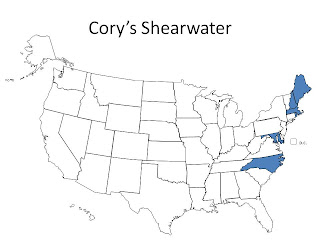Seeing most pelagic species in Rhode Island has been a challenge for me. The local RI birders do organize some pelagic trips into RI waters, but I've never gone on one (yet!). I have been lucky enough to see Razorbill and Common Murre from shore, but the real pelagic species likely require a boat trip. So it was with great interest that I read a post a couple years ago about local RI birders having some pretty good success seeing pelagic birds from the Block Island ferry out of Point Judith. Sort of a poor-man's pelagic trip. The trip is only about an hour each way, moves pretty quickly (even on the slower traditional ferry), and of course won't chase after anything you see. So you've got to be lucky to have the pelagic birds pass pretty close to the ship as you go by. A positive is that the ship is very large, so you generally don't have to worry about rough seas. Over the last couple years I've taken one ferry in summer and one in early spring, and with the exception of a flyby pair of Whimbrels, and the ubiquitous Wilson's Storm-Petrel, I haven't really seen too much. That was before this trip!
I took an early morning trip out of Point Judith to beat the heat. The first Wilson’s Storm-Petrel was just barely outside the Point Judith breakwater, and the birds just kept coming from there. Soon thereafter a Cory’s Shearwater passed right by the bow the boat, then another, then 4 more. My first RI shearwater! A short time later a Manx flew by with its classic fast, fluttering wingbeats. A couple more Cory’s later, I saw a pair of shearwaters on the water up ahead. The boat got close enough to see that 1 was a Cory’s and 1 was a Great. On the way back there were more storm-petrels and less shearwaters in the air. One of the storm-petrels caught my attention as soon as I saw it – noticeably longer wings than the Wilson’s. And it was doing a fair amount of soaring with wings on a dihedral, then deep flaps – a Leach’s Storm-Petrel! I watched it for over 30 seconds until we passed it by. At one point we passed by a flock of 22 shearwaters sitting on the water that were just a bit too far away to ID. Likely most were Cory’s, but who knows what else may have been mixed in. The final tally was 3 species of Shearwaters and 2 species of Storm-Petrels with just 2 hours on the water. And interesting that there were as many shearwaters as storm-petrels. To round out the experience, we passed closely by a Mola mola which I pointed out to others on the ferry.
I've had worse whale watches and pelagics!
Here are the details -
Trip to Block Island - 9:30-10:30 - winds S 5-10, Seas <2 ft
Wilson's Storm-Petrel - 14
Cory's Shearwater - 9 (including 4 together, all flying except 1 on the water)
Manx Shearwater - 1
Great Shearwater - 1 - sitting on the water with a Cory's
Shearwater sp. - 4 (distant flybys, most likely either Cory's or Greats)
Trip Back to Point Judith - 11:30-12:30 - winds S <5, Seas almost calm
Wilson's Storm-Petrel - 25
Leach's Storm-Petrel - 1
Cory's Shearwater - 2
Shearwater sp. - 23 - including a distant flock of 22 on the water (likely Cory's and/or Greats)
Short-billed Dowitcher - 8
Mola mola – 1
